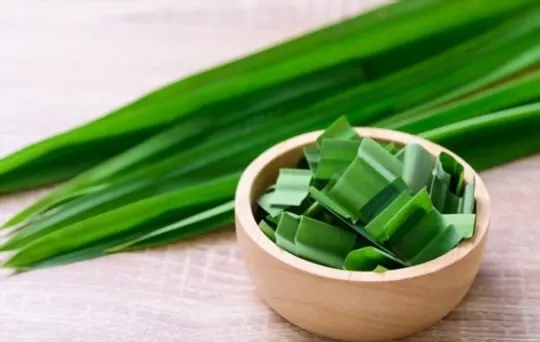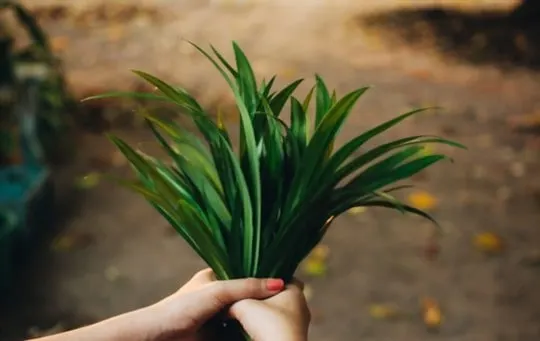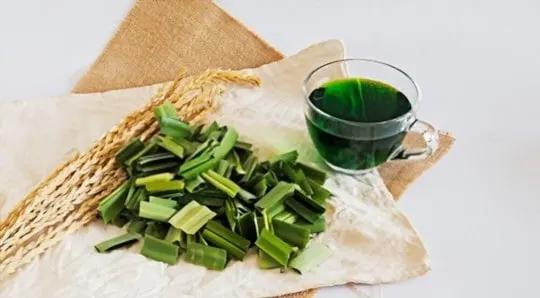Pandan, in Europe, has been tediously named the next matcha, and in Asia, Pandan leaves are used in almost everything, from cooking to natural remedies.
Whether it’s for naturally coloring food, naturally adding flavors, freshening air, insect repelling, etc.
, the aromatic Pandan is a condiment that can be used with versatility.
With several benefits in the culinary scenes, as well as areas of health, Pandan leaves are slowly becoming more well known within the Western world.
But a question arises in our minds, “what does Pandan taste like?” In this article, we will discuss all things Pandan and provide the necessary answers to questions related to Pandan.
What is Pandan?

Pandan is a sultry, tropical plant that’s also known to be a screw pine.
It’s pretty well known for its lengthy and bladed leaves.
These leaves can be made into various savory dishes, refreshing drinks, and wholesome desserts.
Pandan, or Pandanus, is green in color and has extended, narrow features.
It’s been used in recipes for many centuries and is still currently loved by people.
People tend to crush or rub the leaves to release a pungent sweet smell.
They can be found in abundance in Australia and the Southeast Asian areas.
Many people generally blend the leaves into a paste or make them into a green-hued powder or extract.
Moreover, this extract is added to recipes to enhance the meal’s flavor.
Due to its unique flavor profile and distinct scent, Pandan leaves are very famous in the countries of Thailand, Sri Lanka, and other recipes within the South Asian region.
They can be found fresh, dried, or frozen; people use them in chicken wraps, sticky rice wraps, etc.
What Does Pandan Taste Like?

This is where we discuss the most essential bit of the article, i.e., what does Pandan taste like?
Well, it has a flavor profile filled with complexity and has a lot to offer to the gods called taste buds.
Pandan has a uniquely tropical taste, consisting of a hint of floral, a dash of sweetness, and a touch of grassy flavors.
Its taste is compared to that of vanilla and has a distinctive smell.
Pandan’s attribute scent is familiar to that of rice, such as basmati or jasmine, and even white bread.
You can also taste the subtle allure of coconut, almond, and rose scents.
Although it has different flavors in one, it’s still a considerably great palate of flavors built together in the leaves.
Raw Pandan has more of a grassy taste, but if you cook using some Pandan leaves, you can taste a milder, sweeter flavoring.
You will not forget the taste of Pandan when you try it.
Because it’s compared to vanilla, most of the time, it’s known as Southeast Asia’s vanilla.
However, a lot of sources argue that Pandan tastes nothing like vanilla.
Vanilla tastes like a clump of marshmallows because it’s sweet and sugary.
However, Pandan has a similar dessert flavor, but more touches of almond fill its palate.
If you’ve heard of Matcha or Matcha Boba Tea, you probably know it has a nutty and bitter aftertaste.
They are both intended for added coloring & flavoring uses, but the two do not taste the same.
If you have them together, you can expect a delicious and wholesome treat.
How to Use Pandan?

Pandan has a flavoring that’s uniquely tropical and sweet but also very mild, so it can pair well with many dishes.
It’s usually used in rice-based desserts, but Pandan can also be used in various recipes such as mochi, ice cream, jellies, cake, coconut drinks, and so on.
If you want something more savory than sweet, you can use Pandan with bananas, macadamia, almond, etc.
You can also use the Pandan leaves to make yourself a cup of tea.
You just need to boil the leaves and put a teaspoon sugar/honey.
It has a strong aroma, so few people can eat Pandan raw.
If you’re one of them, you can try boiling the leaves in water infused with other ingredients, such as chicken broth or coconut milk.
This broth can be used as soup stock, and you can dice a couple of veggies, put them in the boil and enjoy.
Juicing the leaves is also an option.
You can use a grinder or blender, but if you don’t have either, you can always finish the task with a pair of scissors.
You can either drink the juice whole or take it and make some other dishes such as cupcakes.
You can add flour and pandan extract to the blend using Pandan juice.
Include these and other vegan ingredients, and have the perfect vegan cupcakes with exquisite flavor.
How to Buy Pandan?

Pandan leaves are readily available at Asian grocery stores, but you can also buy them online.
They can be found fresh, dried, or in frozen packs.
They can be parceled as they are, but some packages have the Pandan leaves cut into many pieces.
If you notice that some freshly sold leaves look a little discolored and shriveled up, you shouldn’t buy them because they’ll become stale anytime soon.
If the frozen leaves look a little brown and are dressed in ice crystals inside the packet, then you should avoid them.
If you’re looking for Pandan powder, extract, or paste, you should visit an Asian market.
Many brands selling pandan leaves mask its distinctive smell and taste with other added ingredients, so if you want the original Pandan condiments, make sure the ingredients include only pandan leaves & water.
Once bought, you can take these home and wrap them in a towel that’s been damped with water.
You can even use a damp plastic bag and put it in the refrigerator for about 4 days.
If you want to freeze them, you can place them on a tray and put them in a freezer for almost 6 months.
Conclusion
Pandan is a plant with a tropical background and mild flavors.
Its taste complements foods such as rice, sweet desserts, coconuts, bananas, etc.
They also work well with savory meals by adding a boost of flavor.
Invite your family and friends over to your place for a tea party, and add some pandan juice to your cakes and cookies.
They’re great for people who practice veganism.
Although this article highlighted Pandan leaves and their flavors, you may still be unaware of what it tastes like.
Perhaps you can try it out yourself and find out.

What Does Pandan Taste Like? Does Pandan Taste Good?
Ingredients
- Pandan
- Ingredients from your favorite recipes
Instructions
- Depending on the ingredients used, the cooking method, and the type of dish, the taste of the food can vary greatly.
- Make sure to select a recipe that will elevate the food’s original flavor, and enjoy experimenting with different recipes!

Andrew Gray is a seasoned food writer and blogger with a wealth of experience in the restaurant and catering industries. With a passion for all things delicious, Andrew has honed his culinary expertise through his work as a personal chef and caterer.
His love for food led him to venture into food writing, where he has contributed to various online publications, sharing his knowledge and insights on the culinary world. As the proud owner of AmericasRestaurant.com, Andrew covers a wide range of topics, including recipes, restaurant reviews, product recommendations, and culinary tips.
Through his website, he aims to inspire and educate fellow food enthusiasts, offering a comprehensive resource for all things food-related.

Leave a comment